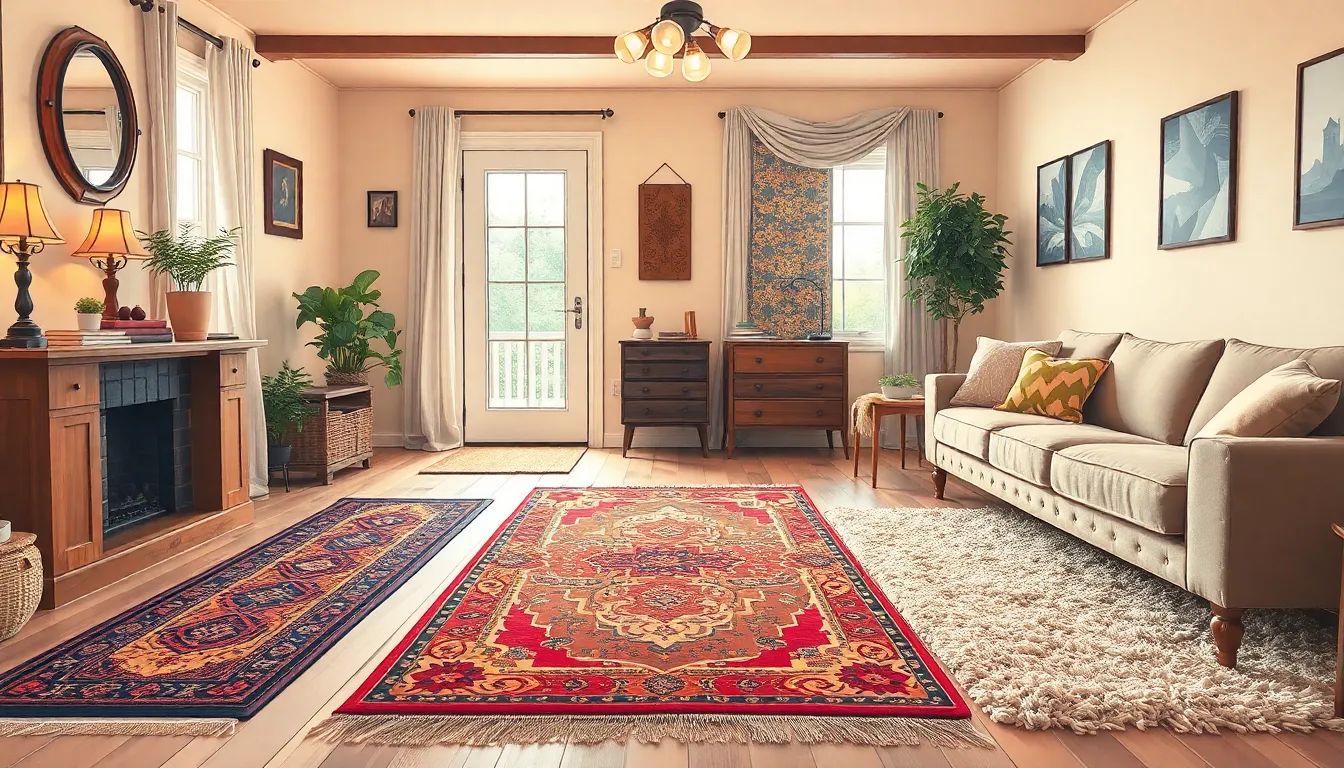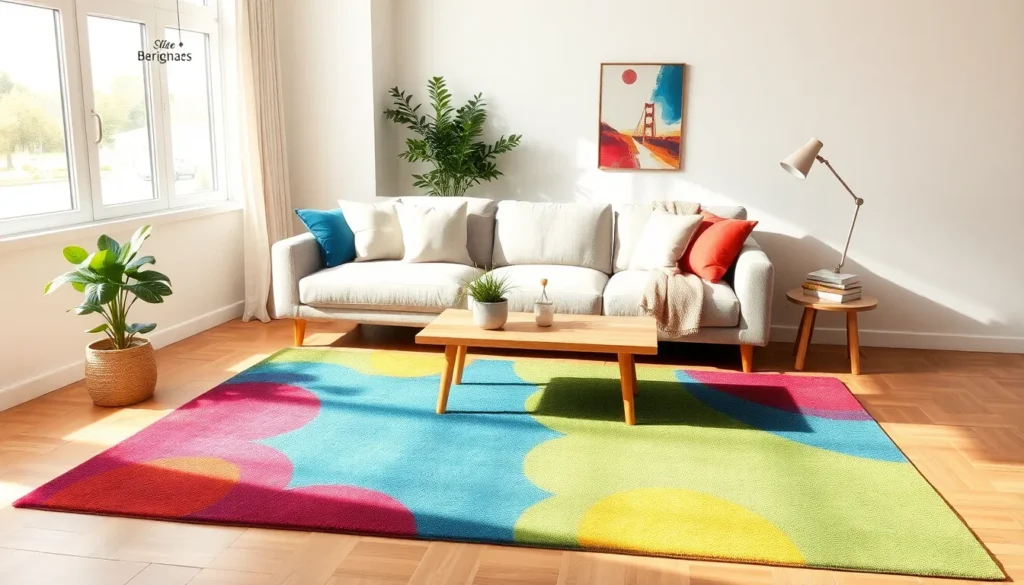A living room rug isn’t just a decorative piece; it’s the unsung hero of home comfort. Picture this: you walk into your living room, and your feet sink into a plush oasis instead of the cold, hard floor. Rugs can transform a space from “meh” to “wow” faster than you can say “where’s the remote?”
Table of Contents
ToggleOverview of Living Room Rugs
Living room rugs serve as an essential foundation for any living space. They provide comfort underfoot and help to define specific areas within larger rooms. Materials commonly used in rugs include wool, cotton, and synthetic fibers, each offering distinct advantages in terms of durability and maintenance.
Colors and patterns play a vital role in selecting a rug. Bold colors can create a focal point, while neutral tones promote a cohesive look. Patterns can add visual interest and personality to a room, aligning with personal style preferences.
Sizes vary significantly, making it easy to find the perfect fit for any living area. Common dimensions range from 5×7 feet to 8×10 feet, accommodating various layouts and furniture arrangements. Layering rugs also offers options for creating depth and texture within a space.
Rug placement significantly influences the overall flow of a living room. Positioning a rug under the front legs of sofas creates a unified appearance, while placing it in a central location can enhance comfort and warmth. Regular maintenance, including vacuuming and rotating, helps extend a rug’s lifespan.
Additionally, rugs contribute to sound absorption, reducing noise levels in busy households. Choosing rugs made with eco-friendly materials supports sustainability, appealing to environmentally conscious consumers. Living room rugs can enhance aesthetic appeal and functionality, providing both style and practicality.
Types of Living Room Rugs

Various types of living room rugs cater to different styles and needs. Understanding these options helps in making an informed choice for comfort and aesthetics.
Area Rugs
Area rugs serve as versatile focal points, ideal for large spaces. Sizes range from 4×6 feet to 9×12 feet, fitting various layouts. These rugs often anchor furniture arrangements, creating a cohesive look. Material choices include wool, cotton, and synthetic fibers, yielding different textures and durability levels. With countless colors and patterns available, area rugs can enhance a room’s character or complement existing décor.
Runner Rugs
Runner rugs deliver a stylish solution for narrow spaces, such as hallways or entryways. Typically measuring 2 to 3 feet wide and up to 12 feet long, they offer practicality and visual interest. Choosing materials like jute or sisal provides durability and ease of maintenance. Runner rugs can also guide foot traffic and create welcoming transitions between rooms. Their designs often feature vibrant patterns or subtle tones, adapting to various design themes.
Shag Rugs
Shag rugs introduce a plush, cozy feel to any living room. Characterized by long fibers, they evoke warmth and comfort. Available in various colors and textures, these rugs suit both modern and vintage styles. Their height can range from 1 to 3 inches, adding depth to a space. Regular maintenance involves vacuuming to keep fibers free from dirt and dust, ensuring they remain inviting.
Flatweave Rugs
Flatweave rugs offer a practical option, known for their thin profile and lightweight construction. These rugs typically feature cotton or synthetic materials, making them easy to clean and versatile. Sizes can vary widely, with styles that complement both casual and formal settings. Flatweave rugs often showcase intricate patterns or geometric designs, enhancing visual appeal without overwhelming a space. Their durability makes them suitable for high-traffic areas, promoting longevity.
Materials Used in Living Room Rugs
Living room rugs come in various materials, each offering unique benefits for comfort and style. Understanding these materials helps in making informed choices.
Wool
Wool rugs provide exceptional durability and a luxurious feel underfoot. Each fiber is naturally stain-resistant, making maintenance easier. Insulation properties help maintain room temperature, enhancing comfort in any season. Wool rugs come in many colors and patterns, allowing for versatile design options. Additionally, they are biodegradable, making them an eco-friendly choice.
Synthetic Fibers
Synthetic fibers, such as nylon and polyester, are popular for their affordability and stain resistance. These materials offer a wide range of colors and designs, appealing to diverse styles. Cleaning synthetic rugs is simple, often requiring just a damp cloth. Durability makes them suitable for high-traffic areas, as they withstand wear and tear. They also tend to be lighter, facilitating easy movement and placement.
Natural Fibers
Natural fibers like jute and sisal are admired for their texture and organic aesthetic. Each fiber is breathable and typically hypoallergenic, contributing to a healthier indoor environment. Natural fiber rugs provide rustic charm and are biodegradable, aligning with sustainability efforts. They may require more maintenance compared to synthetic options, as they can absorb moisture. Suitable for low-traffic areas, these rugs enhance the overall warmth of living spaces.
Choosing the Right Living Room Rug
Choosing the appropriate living room rug involves considering size, color, pattern, and maintenance. Each aspect plays a vital role in enhancing the room’s aesthetic and functionality.
Size Considerations
Selecting the right size for a rug determines its impact on the living space. Rooms with large furniture arrangements benefit from area rugs that extend at least 24 inches beyond the seating area; this creates a unified and cozy setting. For smaller rooms, opting for a rug that fits under the coffee table provides a defined space without overwhelming the area. Room dimensions dictate the rug’s dimensions, ensuring it complements rather than constricts the flow of movement. Measuring the space before making a decision guarantees the chosen rug aligns with functional and visual needs.
Color and Pattern Selection
Color and pattern greatly affect the ambiance of a living room. Bold hues can create a focal point, capturing attention and enhancing overall decor. Neutral colors often promote cohesion, blending seamlessly with various styles and furniture. Patterns add depth but should sync with existing decor to avoid clashing. Choosing a rug with patterns can introduce texture and interest, while subtle designs offer versatility. Considering how light affects color perception throughout the day will lead to an informed decision that elevates the room’s atmosphere.
Maintenance and Care Tips
Maintaining a living room rug requires regular attention to preserve its beauty. Vacuuming once a week removes dirt and debris, preventing fiber damage. For spills, acting quickly with a clean cloth helps prevent stains from setting. Rotating the rug every six months ensures even wear, especially for high-traffic areas. Depending on the material, professional cleaning might be necessary every 1 to 3 years to maintain its appearance and durability. Simple care practices guarantee longevity, allowing the rug to enhance the living space for years.
Benefits of Using Living Room Rugs
Living room rugs provide comfort and warmth, making spaces feel inviting. These pieces define areas, helping to organize layouts in larger rooms. Rugs enhance aesthetics, allowing for bold or neutral designs that can transform an entire room. Additionally, rugs absorb sound, minimizing echo and creating a cozier atmosphere in busy households.
Choosing the right rug material matters. Wool rugs are durable, soft, and naturally stain-resistant. Synthetic fiber rugs, such as those made from nylon and polyester, offer budget-friendly options with easy maintenance. Natural fibers like jute and sisal provide organic charm but may require extra care. Selecting the right material promotes longevity and comfort.
Rugs also contribute to safety by providing a non-slip surface, reducing the risk of falls. Soft textures cushion impacts, making them beneficial in homes with children or elderly residents. Regular maintenance, including vacuuming and rotating, extends a rug’s lifespan while keeping it looking fresh.
Strategically placed rugs enhance flow, connecting furniture and creating visual harmony. Layering rugs adds depth and character, allowing for personal expression in design choices. Modular layouts become more coherent with the right rug placement, drawing attention to furniture arrangements.
Incorporating living room rugs supports sustainability when eco-friendly materials are chosen. Environmentally conscious consumers appreciate options that blend style and ecological responsibility. Overall, investing in a living room rug proves practical, enhancing both comfort and functionality in any home.
Living room rugs are more than just decorative pieces; they play a vital role in enhancing comfort and style. By choosing the right rug, homeowners can create inviting spaces that reflect their personal taste while ensuring functionality.
With various types and materials available, it’s easy to find options that suit any lifestyle and design preference. Regular maintenance helps keep rugs looking their best, ensuring they remain a valuable addition to the home.
Investing in a quality living room rug not only elevates the aesthetic appeal but also improves the overall ambiance, making it a worthwhile consideration for any living space.






